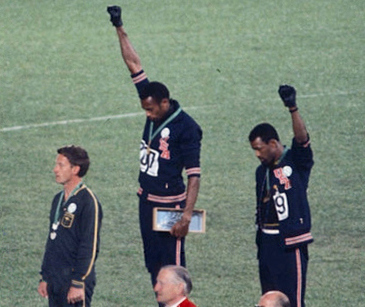The first British Colonizers to North America arrived on a land that they would name Jamestown, Virginia, on May 14, 1607, some 13 years before the arrival of the Pilgrims on the Mayflower and 12 years before the first black bodies arrived on this colonized land in North America as indentured servants. Not being British citizens, African servants weren’t subject to British Common Law and where essentially workers without rights. In 1641, slavery was legalized, reducing the status of blacks to that of chattel, personal property that could be owned for life. By 1660, Slavery had become so profitable that King Charles II of England established “The Royal African Company” to transport humans from Africa to the Americas. They called their human cargo, “Black Gold”.
In a country that has tried to reduce us to nothing more than black bodies; good only for physical labor, pleasure, and entertainment, The Quintessential Gentleman raises its fist in triumphant salute to Black men throughout the history of sports.
Black Athletes have displayed time and time again that our black bodies also have voices, and many have suffered the consequences of daring to speak up and out for the communities that they come from. From Joe Louis, Jackie Robinson and Muhammad Ali to Lebron James and Colin Kaepernick, black men throughout the history of sports have been living embodiments and shining examples of what it means to be black gold in America. Black gold is traded and profited from but never allowed to shine. “Shut up and dribble” is what Lebron James was told in 2018 for having a voice. Black gold is meant to be seen and never heard; expensive statement pieces without a statement. Ornamental. Black gold, to be adorn and treated like a precious collection of jewels — to its owners.
With gloved fists raised and heads bowed, Tommie Smith and John Carlos, humbly accepted their Olympic gold and bronze medals for the 200-meter dash, sending a clear message of black power in protest to their country and team, U-S-A. The date was October 16, 1968, 6 months after the assassination of Dr. Martin Luther King, Jr. The two were immediately suspended from the Olympic team, lost their careers overnight, and returned home to death threats. Though elevated on an Olympic podium, representing American victory and excellence, these two heroes opted out of the opportunity to bask in false glory and adoration, posed as yet another jewel on America’s crown, and instead chose to be silent truth bearers. With no word uttered, Tommie Smith and John Carlos sent a message louder than the roar of the Olympic crowd. A Silent but deafening —“Black Power”.
Though denounced and unappreciated by mainstream America, photographs of this triumphant moment of defiance turned these vilified victors of America, into iconic heroes within the black community. Statues, murals, films and countless other works recapturing this moment are scattered throughout this country’s black communities. 50 years later, this silent protest during the National Anthem proved itself to be iconic in this generation, with many black athletes engaging in various forms of silent protest during the anthem; most notably, taking a knee; spearheaded by former 49er quarterback, Colin Kaepernick. Sadly, and all too true to its original narrative, we find Kaepernick in an all to a familiar position, hated by his country, NFL career over, on the receiving end of countless death threats, but celebrated by his people. Black gold is thrown aside for using its mind. Never mind speaking it. Gold is precious because it never tarnishes but when you’re black gold that only means things never really change.
What then, is there to be celebrated about gold that’s called black?
Aside from their contributions to the American socio-political landscape, black athletes have been major contributors to the wider American culture through business and in fields such as fashion, but also through their action both on and off the field. Michael Jordan’s ability to score a point almost seems to be an afterthought to his display of pure athletic ability. Why just dribble and shoot, when you can jump, spin and — dunk? Actually, make it what you want. Because it hasn’t been forgotten — that to you, we’re black gold; a coin, but I see the way that you spend me when I spin — swing, dribble, dunk — weaving, innovative styles of journalism into a point that I am expected to score. Isn’t that what black gold is for? Jordan Alley-ooped seeds of greatness shaped as basketballs into minds of future black children, because regardless of color, what kid in the 90’s didn’t wanna be like Mike? — A Black Man. Call him what you want, he had millions copin’ the Jordan Sole, and you wonder why in 2018 everyone has so much soul, Michael Jordan — Black, MO-GUL, planted inspirational seeds for the future, Black Gold.
The Late Great Muhammad Ali was known not only for protest and controversy but also for his charismatic personality and charm. He had a way with words and offered many jewels to the American lexicon; he masterfully summed up his brute abilities in his memorable saying: “Float like a butterfly, sting like a bee, Rumble, young man, Rumble”.Who else could so gracefully describe knocking you out? He without a doubt inspired a future generation of black lyricist to spit and flow, leading to a future where Hip-Hop is King and a globe that has embraced its swag and lingo. In the same interview, he braggadociously boasted, “I’m the savior of the whole game! Every day I’m in the newspapers! ya gettin tired of readin ‘bout me… I’m a biiig man!” — One of the more irritable qualities of black gold is that it can’t help its shine. Its reflected light can prove blinding to some, so it’s understandable why they hate it. Ironically, this wouldn’t be so if they would just stop staring. Black gold, called so because all you can see is our shadow as you follow us through aisles of distrust; trending.
Black twitter trends with the actions of black athletes. Today, they are using their voices by continuing to speak up and out, shouting from their platforms, on sports shows, athletic ceremonies, and games, shedding light on inequity the historic and continued injustices in their communities. You cannot just use their black bodies and reject their voices. In 2018, it seems like there has never been a more exciting time to be black, with much thanks to black athletes.
Black gold is controversial because it refuses to do what it’s been told. It breaks the mold and uses the very platform that its owners designed for it to be auctioned and sold, to shout truth to the world, — they shine. Black gold, to be seen and not heard, worn and adorn but if it ever shines, it’s scorned, critiqued and punished, — sold. Black Gold, mistaken for powerless because scattered bricks of gold produce very little shine, but when combined they build a road that’s sure to blind #theblackdollar. Black gold, a prized jewel collected for its qualities and simultaneously hated for its shines. An ungrateful symbol is dissatisfied with its place upon the kings head. This crown speaks volumes and now elevated by this powerful dome, its message is heard. Heated, beaten and crafted into the crown that you see. Even in silence, it speaks. Our shine is involuntary so, who are you to call it bold, or ” thankless pieces of black gold”, “On America’s pedestal; prized, and this what you show?”
The haughtiness of our shine offends, but sets trends, Ungrateful? Hell no. Black athletes elevated on stages meant for their ornamental display, uttering sounds of defiance, sends their buyers into a rage. Especially today. Be it a raised fist or a humble knee, or the way we float like a butterfly and sting like bee, Once MJ had his ball there was no telling what he was going to do with it, only that he would score. Black gold, Statement pieces that can’t speak, The silent truths they reveal were never supposed to be told. Black gold, self-defining, resilient, tried and true. Defiantly shining on raised platforms given to us by you.
Check this out and more in our Sports Issue of The Quintessential Gentleman Magazine..embed-container { position: relative; padding-bottom:56.25%; height:0; overflow: hidden; max-width: 100%; } .embed-container iframe, .embed-container object, .embed-container embed { position: absolute; top: 0; left: 0; width: 100%; height: 100%;}




